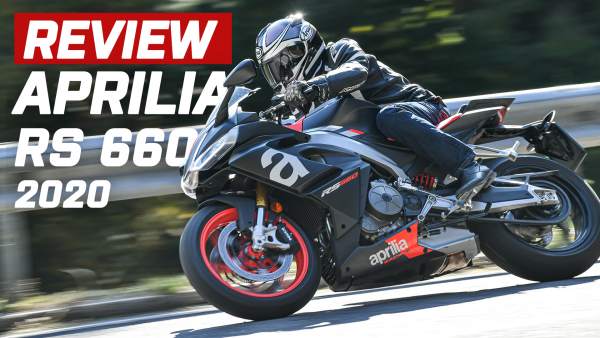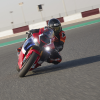
Visordown has been out to Venice to try out the all-new Aprilia RS660 to find out fresh take on the middleweight division will lead a new-breed of supersports machines
FIRST shown as a design concept at EICMA 2018, the Aprilia RS660 is the Noale factory’s take on a modern-day supersports machine.
It’s a fairly new concept and one that only Honda, with the CBR650R, and Kawasaki, with the Ninja 650 have tried out. Traditional supersports bikes with screaming inline four-cylinder engines and 140bhp have fallen out of favour with buyers in recent years. The small gap in price between those and the 1000cc sports bikes was just too narrow, making the lesser machine a hard product to sell.
Aprilia RS660 video review
To help entice riders into the dealerships, Aprilia has launched this middleweight machine with a sting in its tail. The RS660 is the first of this new-breed of supersport bikes to feature the kind of electronics you’d normally find on top-flight sports bikes.
Is it enough to save the flagging middle-weight sports bike sector or even inject new life into the segment? We went to the press launch in Venice to find out.
Aprilia RS660 hire purchase example
Details | |
OTR Price | £10,150 |
Deposit | £3,851 |
Amount of credit | £6,299 |
Term | 36 |
APR | 8.9% |
Interest Rate | 8.56% |
Flat Rate | 4.77% |
Option To Purchase Fee | £10 |
Total Amount Payable | £11,015.27 |
Total Interest | £855.27 |
Monthly Payment (x36) | £199.00 |
Aprilia RS660 design and styling
Sitting on the RS660 for the first time it feels compact but not cramped. The pegs are placed low without compromising ground clearance and the seat is extremely soft and comfortable. The clip-ons are mounted just above the triple clamps, meaning you’ll have to spend a full day in the saddle before there is any sign of aching wrists.
If you are a rider looking at turning your back on sports bike because of sore joints, the new Aprilia could be the perfect antidote to keep you in the saddle.
The overall look borrows heavily from the RSV4, with the headlights, fairing design, and tail unit all aping the look of the more expensive machine. I’d go as far as to say, should you an RS660 in the distance, you’d be hard pushed to tell it apart from its bigger stablemate.
Aprilia RS660 engine
Rather than starting with an entirely new unit, Aprilia began the RS660 project with a product already intricately known to the factory; the RSV4 1100 engine.
After lopping off the rear back of the cylinders, engineers ended up with a 660-HP parallel twin with an 81x64mm bore and stroke. It’s a Euro5 mill that produces a claimed 100hp, and peak torque of 49lb-ft at 8,500rpm. Feeding the engine are two 48mm throttle bodies.
For years now, the parallel-twin layout has been tarred as the less exciting cousin of the inline or V4 configurations. But as firms like Yamaha has shown, with the MT-07 and its CP2 unit, it doesn’t have to be this way. The RS660 engine though takes it to another level in terms of sound, delivery, and excitement.
The motor fuels nicely and is backed up by one of the best exhaust notes of any parallel twin-cylinder on the planet. The spread of torque on offer is vast, enabling the rider to cover up missed downshifts with a big twist of their right hand.
Thanks to that torque, the RS660 accelerates with the kind of urgency you don’t get in this segment, with the balance of power and torque perfect for hammering up a twisting Alpine pass.
Away from the twisties, the engine is perfectly docile when pootling around town, easily chugging its way through villages in sixth gear at 30mph without any fuss or bother. The throttle connection on the bike I rode was generally good, although it was slightly abrupt when initially opening the throttle. I was told it’s something that’ll be sorted on the production bikes though – and I was the only journo who had the issue.
The bike comes equipped with a quickshifter and blipper as standard, another bonus in the sector. For 90 percent of the day, I found it to be okay, although on a few occasions I’d experience a shift that included a slight delay before the power re-engaged.
Again, this could be the pre-production gremlins creeping in or something that, over time, I’d probably learn to live with.
Handling, suspension, and brakes
The Aprilia RS660 is kitted out with what is best described as mid-spec suspension from Kayaba, not the Öhlins as seen on the concept in 2018 – although we’d expect to see that on any future Factory version.
They’re 41mm forks with rebound, compression and spring preload adjustability, while the rear shock is mounted directly to the swingarm with no rising-rate linkage in use and is adjustable for rebound and spring preload. As I found on the launch, the ‘mid-spec’ tag does not mean a mid-spec experience.
The ride around town is as good as it gets on a sports bike, with more support when cornering and braking than rivals like the Ninja 650, but more supple than the all-out supersport machines.
The RS660 is super responsive though, flicking from side to side with very little input from the rider other than some light pressure on the bars. The Pirelli Diablo Rosso Corse II tyres seem like a perfect fit for the bike too, with more than enough grip and feel without dumbing down its eagerness to jump into a corner,
The braking hardware is supplied by Brembo with radially mounted four-pot calipers and 320mm discs at the front and the ABS system is governed by an IMU. The calipers are well up to stopping the bike, although you get the feeling that a set of Stylema Brembos would transform the experience. Initial bite is nice, with plenty of power even when trail braking with a single finger into the tight Italian hairpins.
One of the things that stand this bike ahead of the competition is the IMU controlled ABS system. It’s not a natural fit in the sector and something that is normally the preserve of the 1000cc sports bikes.
That hasn’t hindered the little RS660 though, as it punches well above its weight, with clever algorithms that nestle themselves comfortably within the bike’s systems. The ABS is unobtrusive and precise, just what you want from a nimble and lightweight sports bike.
Equipment
The big news with this bike is the high-level of electronics you get with the thing. It’s definitely a class-leading setup, rivalling the levels of rider aids that some top-flight 1000cc sports bikes get.
The RS660 gets a trick six-axis IMU that controls the cornering ABS, wheelie control, and traction control. That’s already more than either the Honda CBR650R or Kawasaki Ninja 650 gets, and they are really the true rivals of this bike.
On top of that, you get a quickshifter and blipper, engine braking control, cruise control, three road riding modes, and two track-specific riding modes. It really is the most comprehensive electronics package we’ve seen this side of a 20k sports bike.
Up front, the RS660 is blessed with a lovely looking TFT dash that is both pleasing to look at and extremely easy to read.
I’ve got to say, the functions and menus of the bike are all surprisingly easy to use. Too many manufacturers create highly complex methods of changing modes and settings, but the RS660 is refreshingly simple to use.
From activating the cruise control to altering the engine braking, it all feels very intuitive and surprisingly simple.
How easy is it to switch between the riding modes?
To flick between the three road modes, you simply prod the button located below the starter on the right-hand switch cube and the TFT will cycle through the modes. To alter the engine braking, wheelie control or other settings, give the same button a long press and then use the directional pad on the left handlebar to choose the setting and adjust to the desired level. It really is very simple and a blessing for people like me – who prefer to look at the road and not the dash while riding.
Aprilia RS660 vs the rivals
The new Aprilia is being pitched as a stepping-stone between the current crop of middleweight sports bikes. At one end we have track focussed machines like the Yamaha R6, Kawasaki ZX-6R Ninja, and Triumph Daytona 765 Moto2. At the other end, we have the Honda CBR650R and the Kawasaki Ninja 650. It’s more advanced than pretty much all of them, yet not as powerful and focussed as the traditional supersport machines, and much higher spec than both the Kawasaki and the Honda. At £10,150 it's tough to choose where on the scale it slots in though….
Things we like about the Aprilia RS660:
- Easily the best of parallel twin sub-750 engines on the market
- The handling is a perfect mix of sporty dynamics and usable control
- The price - £10k for a twin may sound a lot but there is a lot of bike here
Things we didn’t like:
- The first degree of the throttle could be smoother
- Gear shift isn’t the most precise
- Mirrors are great – if you like looking at your elbows
Verdict
This is a bit of a watershed motorcycle in the modern supersport sector and one I’ve been excited to ride since we first cast eyes on it in 2018. Not a full-fat 600cc track-focussed racer, but not a commuter bike with fairings thrown at if to make it sporty either.
I think the best way I can sum the bike up is by saying this; at the end of the day, when I arrived back at the hotel, an Italian journo hop on my RS660 and headed off into the mountains in the late afternoon sunshine. And I was gutted.
I could have easily carried on, enjoying two, or even three more hours in the saddle of the thing. Aprilia has pitched this bike perfectly.
If you ride solely on the road and never go near the track, the Aprilia RS660 makes some of the more focused supersport machines look like uncomfortable and uncouth wastes of power and potential.
If this is really the future of middle-weight sports bikes, bring it on. And we haven’t even seen the RS660 Factory yet.
Or the Tuono version!
Aprilia RS660 specs
Engine type | Aprilia forward-facing parallel twin, 4-stroke, liquid-cooled with radiator and water-oil heat exchanger, double overhead camshaft (DOHC) with silent chain drive on the right side, four valves per cylinder. |
Bore and stroke | 81 x 63.93 mm |
Displacement | 659 cc |
Compression ratio | 13.5: 1 |
Max power at crankshaft | 100 hp (73.5 kW) at 10,500 rpm |
Max torque at crankshaft | 67.0 Nm (6.83 kgm) at 8,500 rpm |
Fuel system | Airbox with front air intake. 2 48 mm throttle bodies, Ride-By-Wire management |
Ignition | Electric |
Lubrication | Wet sump |
Gears | 6 gears with Aprilia Quick Shift (AQS) up-and-down system |
Clutch | Oil bath multi-disc with anti-hopping system |
Final drive | Chain, 17/43 transmission ratio |
Electronic management | 6-axis inertial platform, APRC suite which includes ATC (traction control, AWC (wheelie control), |
AEB (engine brake), AEM (engine map), ACC (cruise control) | |
5 Riding modes (Road and Track, 3 fixed and 2 customizable) | |
Frame | Double beam aluminium frame with detachable rear seat |
Front suspension | Kayaba upside down fork 41 mm with counter spring, aluminium feet for fixing radial calipers. Adjustable for rebound, compression and spring preload. Wheel travel 120mm |
Rear suspension | Aluminium swingarm with asymmetrical trusses. Monoshock with adjustable counter spring: rebound and spring preload. Wheel travel: 130mm |
Front brake | Double disc diameter 320mm, Brembo radial calipers with 4 32mm opposing pistons, Radial pump and metal braided brake hose |
Rear brake | 220mm diameter disc; Brembo calliper with 2 isolated, 34mm pistons, Pump with integrated tank and metal braided hose |
ABS | ABS Cornering multimap |
Wheels | In aluminium alloy Front: 3.5 "X17" Rear: 5.5 "X17" |
Tyres | Tubeless radials, front: 120/70 ZR 17 rear: 180/55 ZR 17 (alternatively 180/60 ZR17) |
Dimensions | Wheelbase: 1370 mm, Length: 1995 mm, Width: 745 mm, Saddle height: 820 mm |
Rake | 24.1° |
Trail | 104.6 mm |
Weight | 183 kg kerb weight (169 kg dry) |
Homologation | Euro 5 |
Consumption | 4.9 litres / 100km |
CO2 emissions | 116 g /km |
Tank capacity | 15 litres (including 4 lt. fuel reserve) |
Colour range | Apex Black, Lava Red, Acid Gold |
Pictures by Milagro

